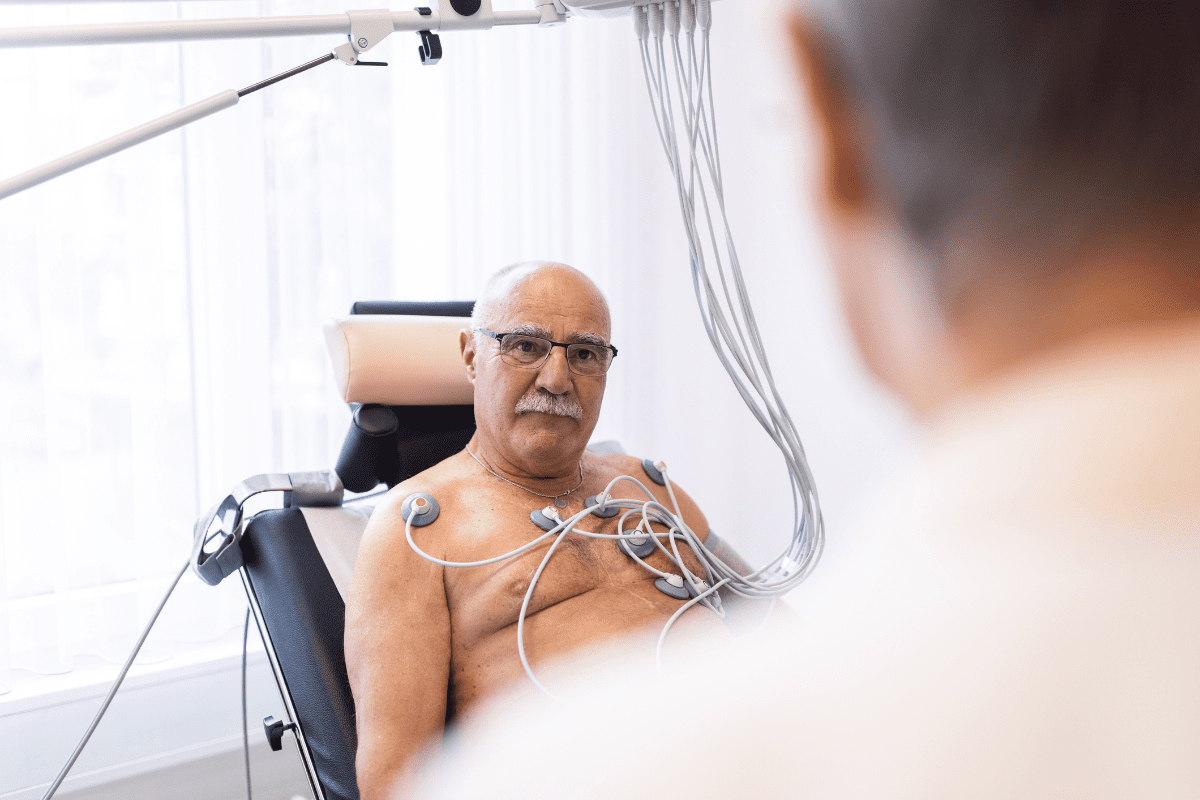Last Updated on November 26, 2025 by Bilal Hasdemir

Ovarian cancer bowel changes can be part of the effects ovarian cancer has on the female reproductive system. This disease can cause symptoms like abdominal bloating, pelvic discomfort, and changes in bowel habits such as constipation or diarrhea. Understanding these effects is key for early detection and treatment of ovarian cancer, which is a significant health concern worldwide.
Did you know ovarian cancer is among the top three gynecologic cancers globally? It’s also the second biggest killer among these cancers. The ovaries, where this cancer mainly happens, are very important for women’s health.
We’ll look at how ovarian cancer impacts the body. Knowing the basics of ovarian cancer helps women take care of their health.
Key Takeaways
- Ovarian cancer mainly hits the ovaries, which are part of the female reproductive system.
- It’s one of the top three gynecologic cancers worldwide.
- Ovarian cancer is the second biggest killer among gynecologic cancers.
- Knowing about the ovaries is key for catching and treating ovarian cancer early.
- Early detection is vital for better treatment results for ovarian cancer.
Understanding Ovarian Cancer

It’s key to know about ovarian cancer for early detection and treatment. Ovarian cancer starts in the ovaries, which are part of the female reproductive system.
Definition and Types of Ovarian Cancer
Ovarian cancer is when cells in the ovaries grow abnormally. There are different types, based on where they start. The most common types are:
- Epithelial ovarian cancer, which starts in the outer layer of the ovary.
- Germ cell ovarian cancer, which starts in the cells that produce eggs.
- Stromal ovarian cancer, which develops in the connective tissue of the ovary.
Studies show that about 90% of ovarian cancer cases are epithelial ovarian cancer.
“Ovarian cancer (OC) is one of the three most common gynecologic malignancies worldwide.” This statement highlights the significance of ovarian cancer as a major health concern for women globally.
Prevalence and Statistics in the United States
Ovarian cancer is a big health issue in the U.S., with thousands of new cases each year. The American Cancer Society says there will be over 19,000 new cases in 2023. Sadly, about 12,000 women will die from it.
| Year | New Cases | Deaths |
| 2020 | 21,750 | 13,940 |
| 2021 | 19,680 | 12,740 |
| 2022 | 19,680 | 12,810 |
It’s important to know the symptoms and signs of ovarian cancer for early detection. Common signs include pelvic pain, bloating, and trouble eating. Knowing these signs can help women get medical help quickly, which can improve treatment chances.
The Female Reproductive System: A Brief Overview

It’s important to understand the female reproductive system to see how ovarian cancer impacts it. This system is made up of many organs that work together. They help with reproduction and support the menstrual cycle.
Anatomy of the Ovaries
The ovaries are key parts of the female reproductive system. They sit on either side of the uterus. These small, almond-shaped organs are vital for reproduction and making hormones.
Inside the ovaries, there are thousands of follicles. Each follicle has an egg that could be fertilized. The ovaries help these eggs develop and get released, a process called ovulation.
Function of the Ovaries in the Body
The ovaries do two main things: they produce eggs and hormones. These hormones control the menstrual cycle. They also help get the uterus ready for pregnancy and support the growing embryo.
The hormones made by the ovaries are key for the female reproductive cycle. If ovarian cancer disrupts this, it can harm a woman’s reproductive health and overall health.
Primary Site: Ovarian Cancer Body Location
Ovarian cancer’s start is complex, with studies pointing to the fallopian tubes. Knowing where ovarian cancer begins is key for better treatments.
Where Ovarian Cancer Usually Starts
Ovarian cancer can start in different cell types in the female body. It was once thought to start in the ovaries. But now, many believe it often begins in the fallopian tubes.
The fallopian tubes are important for egg travel from ovary to uterus. Research shows the tube’s fimbriated end, near the ovary, is a common start for aggressive ovarian cancer.
Different Cell Types and Their Origin Points
Ovarian cancer is made up of different tumor types from various cells. The main types are:
- Epithelial tumors, from the outer ovary or fallopian tube layer.
- Germ cell tumors, from egg-producing cells.
- Stromal tumors, from the ovary’s connective tissue.
Knowing the specific cell type and origin is key for the right treatment. For example, the most common type, epithelial ovarian cancers, might need different treatments than others.
Genetics also play a big role in ovarian cancer. Mutations in BRCA1 and BRCA2 genes raise the risk, mainly for aggressive ovarian cancer.
“The recognition that many ovarian cancers may originate outside the ovary, particular in the fallopian tube, has significant implications for our understanding of the disease and for the development of screening and prevention strategies.”
As research digs deeper, it’s clear we need a tailored approach to fight ovarian cancer. A personalized plan, based on each patient’s cancer, is likely to lead to better results.
The Fallopian Tubes and Ovarian Cancer Connection
The fallopian tubes were once seen as just a passageway. Now, they are known to be a possible source of ovarian cancer. Recent studies have shown how important these tubes are in the growth of ovarian cancer.
Recent Findings on Cancer Origins
Research has found that many ovarian cancers start in the fallopian tubes. This changes the old idea that ovarian cancer mainly starts in the ovaries. The studies point out that:
- High-grade serous ovarian cancers, a common and aggressive type, often start in the fallopian tubes.
- The fimbriated end of the fallopian tube, near the ovary, is a common place for these cancers to develop.
- Genetic mutations, like those in the BRCA1 and BRCA2 genes, raise the risk of cancer in the fallopian tubes.
How Cancer Spreads from Fallopian Tubes to Ovaries
The close location of the fallopian tubes to the ovaries makes it easy for cancer to spread. The process is as follows:
- Cancer cells break off from the fallopian tube’s lining.
- These cells then move to the ovary’s surface, where they can grow.
- The cancer can then spread to other pelvic areas, like the uterus and surrounding tissues.
Knowing about this connection is key for finding ways to prevent and detect ovarian cancer early. It shows why we should look at the fallopian tubes when managing ovarian cancer risk.
How Ovarian Cancer Affects the Pelvic Region
It’s important to know how ovarian cancer impacts the pelvic area. This disease can spread to nearby tissues and organs, causing a lot of pain. The pelvic region, which includes the uterus and fallopian tubes, can be affected in different ways.
Impact on the Uterus
The uterus is a key part of the female reproductive system. Its close location to the ovaries makes it vulnerable to ovarian cancer. As the disease grows, it can invade the uterus or spread to it indirectly. This can cause symptoms like pelvic pain and unusual bleeding.
Effects on the Uterus:
- Direct invasion by ovarian cancer cells
- Indirect effects due to tumor spread or metastasis
- Symptoms such as pelvic pain and abnormal uterine bleeding
Effects on Surrounding Pelvic Tissues
Ovarian cancer can also harm the tissues around the pelvic area. This includes ligaments, blood vessels, and nerves. It can lead to pain, discomfort, and problems with urination or bowel movements. Cancer spreading to these areas can greatly affect a patient’s life quality.
The complexity of the pelvic region makes it challenging to treat ovarian cancer that has spread to this area.
| Pelvic Structure | Effect of Ovarian Cancer | Common Symptoms |
| Uterus | Direct invasion or indirect effects | Pelvic pain, abnormal bleeding |
| Surrounding Tissues | Cancer spread, inflammation | Pelvic pain, discomfort, urinary/bowel issues |
We’ve talked about how ovarian cancer affects the pelvic area. This includes its impact on the uterus and surrounding tissues. Knowing these effects is key to creating effective treatments and improving patient outcomes.
Abdominal Cavity Involvement
Ovarian cancer often spreads to the abdominal cavity. This can cause big changes in the body. It can reach different parts of the cavity, touching organs and tissues.
The abdominal cavity, or peritoneal cavity, holds important organs like the intestines, stomach, and liver. When ovarian cancer reaches this area, it can spread cancer cells all over.
Peritoneal Spread of Ovarian Cancer
The peritoneum is a thin layer of tissue that covers the organs in the abdominal cavity. Ovarian cancer often spreads to the peritoneum, a process called peritoneal dissemination. This can cause fluid buildup in the cavity, known as ascites.
Peritoneal spread is a key part of ovarian cancer growth. It can make the disease worse. Cancer cells in the fluid can spread disease all over the abdominal cavity.
Omentum and Mesentery Involvement
The omentum and mesentery are important parts of the abdominal cavity. The omentum hangs from the stomach, and the mesentery attaches the intestines to the back of the abdominal wall. Ovarian cancer can spread to both, forming tumor deposits.
These deposits can cause pain and swelling in the abdomen. They can also make surgery harder.
Understanding how ovarian cancer spreads in the abdominal cavity is key to good treatment plans. Doctors can then tailor treatments to meet each patient’s needs.
Digestive System Organs Affected by Ovarian Cancer
Ovarian cancer doesn’t just affect the reproductive system. It can also harm digestive organs. As it grows, it can touch different parts of the digestive system. This can make life harder for patients.
Impact on the Bowel and Intestines
The bowel and intestines often get hit by ovarian cancer, mainly in later stages. Bowel obstruction is a big problem. It happens when cancer blocks the intestines, causing pain, nausea, and trouble with bowel movements.
At times, ovarian cancer can create adhesions or adnexal masses. These can press on the intestines, making digestion and bowel movements even harder. Knowing about these risks helps us take better care of our patients.
Effects on the Stomach and Liver
Ovarian cancer can also affect the stomach and liver. It can spread directly or through metastasis. When it reaches the stomach, it can cause nausea, vomiting, and discomfort. In the liver, it can lead to elevated liver enzymes and even liver failure.
Liver metastasis from ovarian cancer is a serious sign. It usually means the disease is more advanced. We must keep a close eye on liver function in ovarian cancer patients.
Understanding how ovarian cancer affects the digestive system helps us manage the disease better. We need to think about how it impacts the bowel, intestines, stomach, and liver when planning treatments.
Urinary System Complications
Ovarian cancer can cause big problems in the urinary system. This affects how well patients live their lives. As the cancer grows, it can mess with the urinary system in many ways. This leads to uncomfortable symptoms and serious health problems.
We will look at two main issues: bladder problems in advanced stages and how it affects the kidneys.
Bladder Involvement in Advanced Stages
In later stages, ovarian cancer can harm or press on the bladder. This causes a variety of urinary symptoms. These symptoms include:
- Frequent urination
- Urinary urgency
- Painful urination
- In some cases, blood in the urine
Managing bladder symptoms is key to keeping patients comfortable. Doctors use different methods to help. These include treatments to ease symptoms and improve how the bladder works.
Kidney Function and Ovarian Cancer
Ovarian cancer can also harm the kidneys. This happens if the cancer spreads to or presses on the ureters. The ureters are tubes that carry urine from the kidneys to the bladder. This can cause:
- Hydronephrosis, a condition where the kidney swells because urine can’t drain properly
- Potential kidney damage if not treated
Monitoring kidney function is very important in managing ovarian cancer, mainly in advanced cases. Regular checks help doctors spot problems early. This allows for quick action to avoid lasting damage.
Understanding the urinary system problems linked to ovarian cancer helps patients and doctors. They can work together to manage symptoms well. This improves treatment results.
Distant Metastasis: Beyond the Pelvis and Abdomen
Distant metastasis is a key part of ovarian cancer growth, affecting organs like the lungs and liver. Knowing how ovarian cancer reaches these areas is vital for making treatment plans better and helping patients.
Spread to the Lungs
The lungs are often where ovarian cancer spreads first. This can cause symptoms like shortness of breath, coughing, and chest pain. When cancer reaches the lungs, it usually means the disease is more advanced, needing different treatments to manage symptoms and slow it down.
Recent studies show how important it is to watch for lung metastases in ovarian cancer patients. Finding cancer early in the lungs helps doctors choose the right treatments. These might include chemotherapy, targeted therapy, or other methods to ease symptoms and improve life quality.
Other Common Sites of Metastasis
Ovarian cancer can also spread to other distant organs, like the liver, bones, and brain. The liver is a common site because of its blood supply and location near the abdomen. Liver metastases can cause jaundice, abdominal pain, and changes in liver function.
| Organ | Common Symptoms of Metastasis | Typical Treatment Approaches |
| Lungs | Shortness of breath, coughing, chest pain | Chemotherapy, targeted therapy, symptom management |
| Liver | Jaundice, abdominal pain, changes in liver function | Chemotherapy, localized treatments (e.g., ablation) |
| Bones | Pain, fractures, hypercalcemia | Radiation therapy, bisphosphonates, pain management |
It’s important for healthcare providers to understand how ovarian cancer spreads to distant sites. By knowing where cancer can go and the symptoms it causes, we can make better treatment plans. This helps us manage the disease better and improve patient care.
Physical Symptoms Based on Affected Body Parts
Ovarian cancer can cause various symptoms as it grows. These symptoms depend on the body parts affected. Knowing these symptoms is key for early detection and treatment.
Pelvic and Abdominal Symptoms
The pelvic area is often affected by ovarian cancer. Symptoms here include pelvic pain or discomfort. This pain can be constant or come and go.
As the cancer grows, it can cause abdominal bloating or swelling. This happens when fluid builds up in the belly, known as ascites.
Changes in bowel habits, like constipation or diarrhea, can also occur. This is because the tumor affects the intestines. Some women may feel abdominal pain or tenderness. This could mean the cancer has spread to other parts of the abdomen.
Systemic Symptoms from Metastatic Disease
When ovarian cancer spreads to other parts of the body, it can cause various symptoms. For example, if it reaches the lungs, you might feel short of breath or cough a lot. If it goes to the liver, you might see jaundice or changes in liver function.
Systemic symptoms also include feeling fatigued or weak. This is common in many cancers, including ovarian cancer. Weight loss is another symptom that can happen, mainly in later stages of the disease.
It’s important to recognize these symptoms and understand their link to ovarian cancer. If you or someone you know is showing these signs, seeing a healthcare professional is vital. They can provide the right evaluation and care.
Diagnosis: Identifying Affected Areas
Getting a correct diagnosis of ovarian cancer is key to making a good treatment plan. It involves using different tools and methods. These steps help us see how far the disease has spread.
Imaging Techniques for Detecting Spread
Imaging is very important in finding ovarian cancer and seeing if it has spread. We use tools like ultrasound, CT scans, MRI, and PET scans. These help us see the ovaries and nearby areas clearly.
Ultrasound is often the first test used. It helps find ovarian masses and check their type. CT scans give more details about the tumor’s size and if it has spread. MRI shows high-resolution images to tell if a tumor is cancerous. PET scans help find cancer in distant parts of the body.
Surgical Assessment and Staging
Surgery is a big part of diagnosing ovarian cancer. It helps us see how far the disease has spread. We remove the tumor and affected tissues to understand the cancer’s stage.
During surgery, we check the abdominal cavity and lymph nodes for cancer. We also take tissue samples for biopsy. Knowing the cancer’s stage is important for planning treatment.
Treatment Approaches Based on Affected Areas
Knowing where ovarian cancer is located is key to picking the right treatment. The way we treat ovarian cancer changes a lot based on where the cancer is and how far it has spread.
Surgical Interventions for Different Organs
Surgery is a big part of treating ovarian cancer, mainly when it’s in one place. Cytoreductive surgery tries to take out as much of the tumor as it can. This makes other treatments work better.
If ovarian cancer is in the pelvic area, doctors might take out the ovaries, fallopian tubes, and sometimes the uterus. If it’s in other organs like the bowel or bladder, more surgery is needed.
| Affected Area | Surgical Intervention |
| Ovaries and Fallopian Tubes | Salpingo-oophorectomy |
| Uterus | Hysterectomy |
| Bowel | Bowel Resection |
Targeted Therapies for Specific Locations
Targeted therapies are a precise way to fight ovarian cancer. They target specific parts of the cancer that help it grow and spread. PARP inhibitors are used when the cancer has certain genetic changes.
For cancer in the peritoneal cavity, intraperitoneal chemotherapy is a good option. It puts chemotherapy right where it’s needed.
Every patient is different, and treatments are made just for them. By using surgery and targeted therapies together, we can create plans that really help patients.
Risk Factors and Prevention Strategies
Knowing the risk factors for ovarian cancer is key to preventing it. We can lower the disease’s rate by identifying high-risk groups and taking steps to protect them.
Genetic and Environmental Risk Factors
Ovarian cancer risk comes from genes, environment, and lifestyle. Genetic mutations in BRCA1 and BRCA2 genes raise the risk a lot. Women with a family history of ovarian or breast cancer are also at higher risk.
Environmental and lifestyle factors also matter. For example, never having kids or having a first child late in life can up the risk. Using certain fertility drugs and hormone therapy also increases the risk.
| Risk Factor | Description | Impact on Risk |
| Genetic Mutations (BRCA1 & BRCA2) | Inherited mutations in these genes | Significantly increases risk |
| Family History | Having close relatives with ovarian or breast cancer | Increases risk |
| Reproductive Factors | Never having children or first pregnancy at an older age | Increases risk |
Preventive Measures and Early Detection
While some risks can’t be changed, there are steps to lower ovarian cancer risk. For those at high risk, prophylactic salpingo-oophorectomy is very effective. Others can use oral contraceptives to lower their risk.
Early detection is also key. Regular pelvic exams and transvaginal ultrasound can catch ovarian cancer early. This makes treatment more effective. Scientists are working on better screening tests.
By understanding risks and taking preventive steps, we can fight ovarian cancer. It’s vital for women to talk to their doctors about their risk and how to lower it.
Conclusion
Ovarian cancer is a complex disease that affects the female reproductive system. It’s important to understand where it starts, how it spreads, and its impact on other organs. This knowledge is key to managing the disease effectively.
The prognosis and survival rate for ovarian cancer depend on when it’s diagnosed and the treatment’s success. Thanks to early detection and new treatments, many patients are living longer.
Research into ovarian cancer is ongoing and vital. It helps us understand the disease better and find new ways to treat it. These efforts promise to improve life for those with ovarian cancer.
As we learn more about ovarian cancer, a complete approach is needed. This includes raising awareness, finding cancer early, and using innovative treatments. Supporting research and helping patients are steps towards better outcomes and survival rates.
FAQ
What part of the body does ovarian cancer typically affect?
Ovarian cancer mainly hits the ovaries, which are key to the female reproductive system. It can also spread to the pelvic area, the belly, and other distant organs.
Where does ovarian cancer usually start?
Studies show ovarian cancer might start in the fallopian tubes. Then, it moves to the ovaries. But, where it starts can vary based on the type of cancer.
How does ovarian cancer affect the pelvic region?
Ovarian cancer can affect the uterus and tissues around it. This can cause pelvic pain and pressure on nearby organs.
What is peritoneal spread in ovarian cancer?
Peritoneal spread means ovarian cancer cells spread to the belly’s lining, called the peritoneum. This can involve many organs in the belly.
How does ovarian cancer affect the digestive system?
Ovarian cancer can hit the bowel, intestines, stomach, and liver. This can cause symptoms like bowel blockage and liver spots.
What urinary system complications can occur with ovarian cancer?
Ovarian cancer can affect the bladder and kidneys, mainly in advanced stages. This can lead to bladder issues and kidney problems.
Can ovarian cancer spread to the lungs?
Yes, ovarian cancer can spread to the lungs and other distant organs.
What are the physical symptoms of ovarian cancer based on the affected body parts?
Symptoms include pelvic and belly pain, swelling, and discomfort. Systemic symptoms like fatigue and weight loss can happen if the cancer spreads.
How is ovarian cancer diagnosed?
Diagnosis uses imaging like ultrasound and CT scans to find cancer. It also involves surgery to check how far the disease has spread.
What are the treatment approaches for ovarian cancer based on the affected areas?
Treatment includes surgery to remove affected organs. It also includes targeted therapies based on the cancer’s location and type.
What are the risk factors for ovarian cancer?
Risk factors include genetic predisposition, family history, and environmental factors. Knowing these is key for prevention and early detection.
How can ovarian cancer be prevented or detected early?
Prevention includes regular check-ups and genetic testing for those at high risk. Being aware of early symptoms is also important. Early detection greatly improves treatment chances.
References
- Centers for Disease Control and Prevention. (2023). Basic information about ovarian cancer. https://www.cancer.gov/types/ovarian






